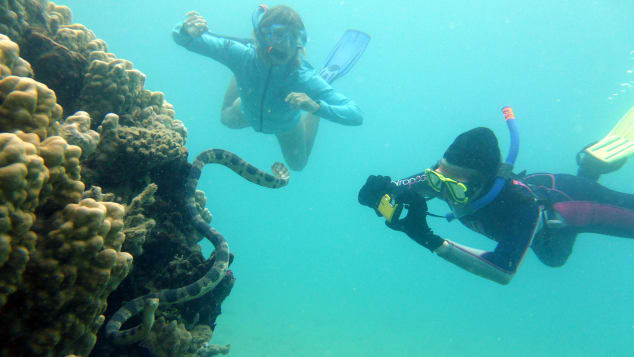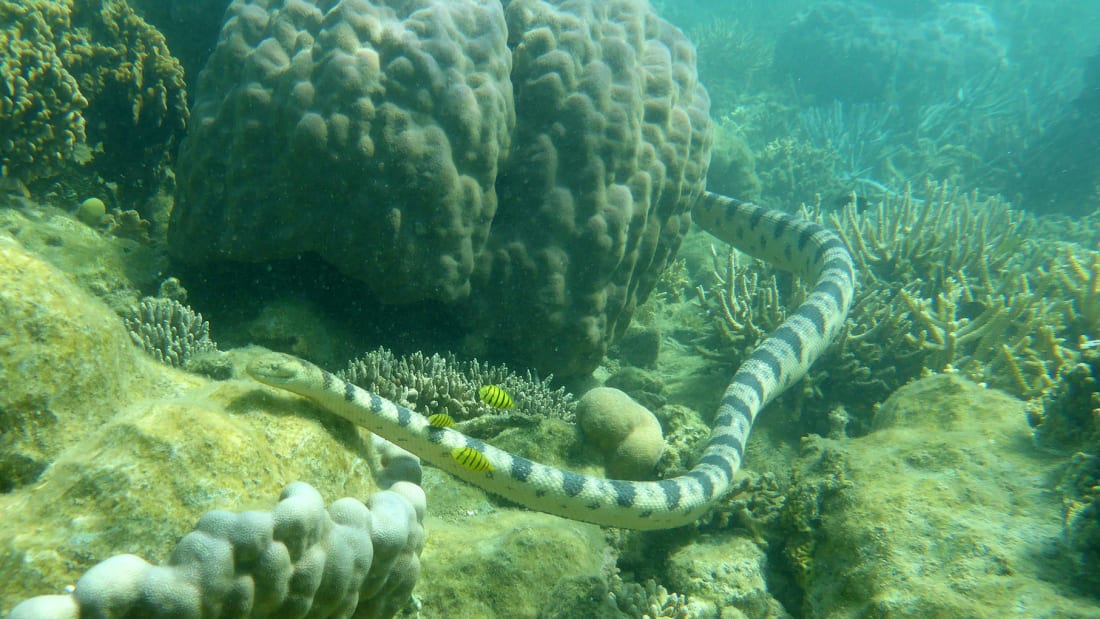Leisure Pleasures for Grandmothers in New Caledonia
"The study zone is in the most touristic bay in Noumea, so I often meet people when I am doing field work on sea snakes. When I was snorkelling on my own studying sea snakes, I used to meet a friend of mine called Aline that was snorkelling and taking photos on the same reef. In order to help me, she started taking photos of sea snakes and would send them to me by mail."
"We stated chatting in the water and I explained to her what I was doing, and she told me she wanted to help."
"As soon as the grandmothers set to work, we realized that we had massively underestimated the abundance of greater sea snakes in the bay. We realized they are important mesopredators on the reef."
"If there is one thing I want everyone to learn from this, it's that you should never underestimate grandmothers."
Claire Goiran, marine biologist, University of New Caledonia
"We meet every morning between 8 a.m. and 8:30 a.m. We wear our diving equipment and we swim for one hour or two."
"Sometimes in summer, we can swim for three hours. Back on the beach we have tea and enjoy the beauty of the site. It is very relaxing."
Marilyn Sarocchi, 63, New Caledonia, Coral Sea
 |
| The “fantastic grandmothers,” from left: Geneviève Briançon, Aline Guémas, Monique Zannier, Monique Mazière, Sylvie Hébert, Cathy Le Bouteiller and Marilyn Sarocchi. Image by Claire Goiran/UNC. |
The journal Ecosphere recently published an article highlighting an unusual collaboration between scientists studying the presence of sea snakes around the waters off the coast of Australia and the French territorial island archipelago nearby of New Caledonia teeming with over 9,300 marine species, including dugongs, manta rays and venomous sea snakes. The greater sea snake, which can reach close to 1.5 meters in length, capable of killing a human with a single bite, among them.
Sea snakes for the most part live offshore and given that they are expressly dangerous to handle, few scientists are inclined to risk studying the species and their hard-to-reach habitat. Rick Shine, an evolutionary biologist at Macquarie University, Australia, and Claire Goiran from the University of New Caledonia paired up to find out what they were able to, about the greater sea snake.
Their efforts to survey the Baie des Citrons, a bay in Noumea, the capital of New Caledonia, were not very effective. They had a limited time frame to spare, and lacked full-time volunteers as assistants so theirs was a slow start. In the first three years of their study they managed to catalogue a mere 45 greater sea snakes. But then, in June of 2017, a fortuitous meeting took place on a beach between Dr. Goiran and Aline Guemas, a 61-year-old retiree, who offered to help in the search.
 |
Monique Mazière and Sea Snake 79, nicknamed "Déborah."
Claire Goiran/University of New Caledonia
|
Ms. Guemas came along with Dr. Goiran on weekly surveys to photograph sea snakes and record the location where they were found. This turned out to be extremely useful for Dr. Goiran who soon suggested to Ms. Guemas she might recruit other retirees to volunteer for the same purpose. Soon, a team of seven volunteers had been assembled, their enthusiasm and usefulness soon becoming obvious, earning them the sobriquet of the "fantastic grandmothers".
Since they began their volunteer work on the bay, hundreds of snorkel surveys have taken place in the Baie des Citrons, where they identified hundreds of greater sea snakes. Monique Zannier, 75, one of the women whose ages range from 60 to 79, admits to no concern over the reputation of the sea snakes. "The Baie des Citrons is our playground", she boasts.
 |
| A group of snorkeling women who call themselves the “fantastic grandmothers” is helping scientists better understand the venomous greater sea snake. Image by Claire Goiran/UNC. |
The researchers now rely on the women to help numerate and track the hundreds of greater sea snakes that come into Noumea's bays. Their data collection includes greater detailed information on the ecology of greater sea snakes than is found for any other wide-ranging sea snakes worldwide, according to Harold Heatwole, professor of zoology at the University of New England in Australia.
"Remarkably, they found a large number of lethally toxic sea snakes in a small bay that is occupied every day by hordes of local residents and cruise ship passengers — yet no bites by the species have ever been recorded at Baie des Citrons, testifying to their benevolent disposition."
Rick Shine, evolutionary biologist, Macquarie University, Australia
 |
Two of the grandmother dive to photograph the snake's tail for identification.
Claire Goiran
|
"I have been studying sea snakes in the Baie des Citrons for 20 years, and thought I understood them very well — but the Fantastic Grandmothers have shown me just how wrong I was."
"The incredible energy of the Grandmothers, and their intimate familiarity with ‘my’ study area, have transformed our understanding of the abundance and ecology of marine snakes in this system. It’s a great pleasure and privilege to work with them."
Claire Goiran
These remarkable women have documented at least 250 of the snakes. They showed through photographs they've taken, that within a 25-month period 140 greater sea snakes visited the Baie des Citrons, suggesting that greater sea snakes may have a larger role in the ecosystem function than previously thought, as animals in the middle of a food chain; both predators and prey.
The conservation status of at least 23 species of the sea snakes is unknown, resulting from a lack of data, leaving Dr. Goiran to hope that their data collected by the grandmothers will be of help to conservationists in improving protection for sea snakes of which only two of the 60 species in total are considered critically endangered.

Labels: Biosphere, Environment, Nature, Science, Sea Snakes

0 Comments:
Post a Comment
<< Home